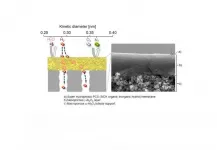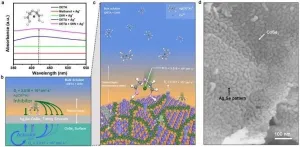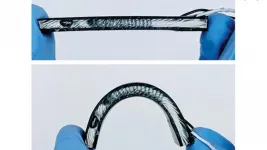Novel hydrogen fuel purification membrane paves the way for greener future
Researchers develop a novel membrane that efficiently purifies hydrogen fuel from a mixture of gases
2021-03-08
(Press-News.org) Hydrogen has been hailed as the 'fuel of the future' owing to several reasons. First, compared to the conventionally used hydrocarbons, hydrogen exhibits higher energy yield. Second, the commercial use of hydrogen fuel, which yields only water as a byproduct product, would help mitigate the imminent global warming crisis by reducing the use of exhaustible and polluting fossil fuels. Thus, ongoing research has been focusing on efficient and environment-friendly ways to produce of hydrogen fuel.
Solar hydrogen production through photoelectrochemical (PEC) water-splitting reaction is an attractive "green" method of hydrogen fuel production, owing to its potential for high conversion efficiency, low operating temperatures, and cost-effectiveness. However, efficient separation of hydrogen gas from a mixture of gases (called "syngas") under different environmental conditions, has proven to be a challenge. A recent paper published in the journal Separation and Purification Technology seeks to address this challenge. In this study, a group of researchers from Nagoya Institute of Technology, Japan, led by Professor Yuji Iwamoto, in collaboration with researchers in France, successfully characterized a novel membrane that allows highly selective separation of hydrogen gas generated from the PEC reaction. Prof. Iwamoto says, "Membrane separation is attractive as a low-cost hydrogen gas purification technology. However, current techniques face several challenges, for example, water-induced swelling with polymer membranes and lower hydrogen permeance with metal, polymer, and supported liquid membranes. "
The researchers first developed an organic-inorganic hybrid polymeric membrane, primarily consisting of a polymer called "polycarbosilane" (PCS) formed on an aluminium oxide (Al2O3)-based porous support. Prof. Iwamoto further explains, "By using high-molecular-weight PCSs with a melting point above 200°C, we showed that a superhydrophobic PCS membrane could be deposited on a mesoporous γ-Al2O3-modified macroporous α-Al2O3 tubular support. "
After successfully developing the PCS membrane, the researchers tested it under PEC reaction conditions. As hypothesized, the PCS membrane showed high hydrophobicity. Moreover, under the flow of a simulated highly humid gas mixture at 50°C, the PCS membrane exhibited excellent hydrogen selectivity. Further analysis revealed that the preferential hydrogen permeation through the PCS membrane was governed by the "solid state diffusion" mechanism. Overall, irrespective of the ambient environmental conditions provided, the PCS membrane exhibited efficient hydrogen gas separation.
With the development and characterization of this new PCS membrane, it is inevitable that its commercial adoption will not just facilitate the use of hydrogen fuel for energy needs but also curb the use of non-renewable fossil fuels. Prof. Iwamoto concludes, "With this technological development, we expect great progress in environmental-friendly and sustainable hydrogen production ."
Let's hope that the use of PCS membrane is a step towards a hydrogen-based society!
INFORMATION:
About Nagoya Institute of Technology, Japan
Nagoya Institute of Technology (NITech) is a respected engineering institute located in Nagoya, Japan. Established in 1949, the university aims to create a better society by providing global education and conducting cutting-edge research in various fields of science and technology. To this end, NITech provides a nurturing environment for students, teachers, and academicians to help them convert scientific skills into practical applications. Having recently established new departments and the "Creative Engineering Program," a 6-year integrated undergraduate and graduate course, NITech strives to continually grow as a university. With a mission to "conduct education and research with pride and sincerity, in order to contribute to society," NITech actively undertakes a wide range of research from basic to applied science.
About Professor Yuji Iwamoto from Nagoya Institute of Technology, Japan
Dr. Yuji Iwamoto is a Professor at Department of Life Science and Applied Chemistry, Nagoya Institute of Technology, Japan. Prof. Iwamoto's expertise lies in the field of inorganic material and their physical properties. He was the recipient of the prestigious Richard M. Fulrath Award in 2006. Some of his ongoing research projects are in gas separation membranes and functional ceramics. His academic affiliations include the Ceramic Society of Japan and Materials Research Society. He has published over 200 articles in reputed journals.
[Attachments] See images for this press release:

ELSE PRESS RELEASES FROM THIS DATE:
2021-03-08
Research from the University of Kent predicts an end to deregulated competitive pubic transport in the UK as a consequence of Covid-19 social distancing measures leading to drastically reduced ridership, requiring a major rethinking of the provision of public transport.
This paper, published in Transport Policy, argues that the situation will require a fundamental approach to long-term policy for transport as a whole. This is an opportunity to reconstruct the system whilst addressing such problems as the environmental impact of transport, congestion and questions of transport justice such as accessibility ...
2021-03-08
A new substance could improve the treatment of persistent cancers. Researchers at Martin Luther University Halle-Wittenberg (MLU) and the University of Greifswald have developed a new inhibitor that makes drug-resistant tumour cells respond again to chemotherapy. The new substance blocks a protein in the cancer cells that normally transports the cancer drugs back out of the cells. The results were published in the scientific journal Molecules.
In addition to radiation therapy, cytotoxic agents, also known as chemotherapy, are frequently used to treat cancer. They prevent cells from dividing and thus cancer cells are unable to multiply unchecked. "Cytotoxic agents remain a very important form ...
2021-03-08
In 1952, Alan Turing, the father of computer science and artificial intelligence, proposed that certain repetitive natural patterns may be produced by the interaction of two specific substances through the "reaction-diffusion" process. In this system, activator promotes the reaction and inhibitor inhibits the reaction. When the two meet, the reaction diffuses. When the difference in diffusion coefficient between the two reaches a certain level, the high diffusion ratio between them will cause the system imbalance and induce the formation of periodic complex patterns.
"Turing structure" exists widely in nature, such as the body patterns of zebras, the phyllotaxis of sunflowers, the follicle spacing of ...
2021-03-08
The precise choice of treatment for breast cancer depends upon the status of the hormone receptors (for oestrogen and progesterone). Their conventional determination by means of immunohistochemistry (IHC) is associated with a certain error rate, which can be reduced by adding genomic data. Even conventional statistics can bring about a notable improvement but now it is possible to use decision theory to optimally combine diagnostic findings, particularly where they are contradictory. This is the finding of a recent study conducted by MedUni Vienna under the leadership of Wolfgang Schreiner from the Center for Medical Statistics, Informatics and Intelligent Systems (CeMSIIS). The methodology has applications way beyond breast cancer and can be deployed ...
2021-03-08
Recently, research group, led by Prof. FU Yao and associate research fellow LU Xi From Hefei National Laboratory for Physical Sciences at the Microscale and School of Chemistry and Materials Science of the University of Science and Technology of China (USTC), has made significant achievements in the field of synthesis of chiral amines. They developed a mild and general nickel-catalysed asymmetric reductive hydroalkylation and realized the modular synthesis of chiral aliphatic amines.
Results were published in Nature Communications on Feb. 26, 2021.
Chiral amines are important chiral auxiliaries and key synthetic intermediates of pharmaceuticals and natural products. ...
2021-03-08
With the help of the European Southern Observatory's Very Large Telescope (ESO's VLT), astronomers have discovered and studied in detail the most distant source of radio emission known to date. The source is a "radio-loud" quasar -- a bright object with powerful jets emitting at radio wavelengths -- that is so far away its light has taken 13 billion years to reach us. The discovery could provide important clues to help astronomers understand the early Universe.
Quasars are very bright objects that lie at the centre of some galaxies and are powered by supermassive black holes. As the black hole consumes the surrounding gas, energy is released, allowing astronomers to ...
2021-03-08
Astronomers using the National Science Foundation's Karl G. Jansky Very Large Array (VLA) and Very Long Baseline Array (VLBA) have found and studied the most distant cosmic jet discovered so far -- a jet of material propelled to nearly the speed of light by the supermassive black hole in a quasar some 13 billion light-years from Earth. The quasar is seen as it was when the universe was only 780 million years old, and is providing scientists with valuable information about how galaxies evolved and supermassive black holes grew when the universe was that young.
The studies indicate that the quasar -- a galaxy harboring a black hole 300 million times more massive than the Sun -- has a jet of fast-moving particles only about 1,000 years ...
2021-03-08
COLUMBUS, Ohio - Multinational companies headquartered in countries with tougher environmental policies tend to locate their polluting factories in countries with more lax regulations, a new study finds.
While countries may hope their regulations will reduce emissions of carbon dioxide and other greenhouse gases, these results show that these policies can lead to "carbon leakage" to other nations, said Itzhak Ben-David, co-author of the study and professor of finance at The Ohio State University's Fisher College of Business.
"Firms decide strategically where to locate their production based ...
2021-03-08
North Carolina State University engineers continue to improve the efficiency of a flexible device worn on the wrist that harvests heat energy from the human body to monitor health.
In a paper published in npj Flexible Electronics, the NC State researchers report significant enhancements in preventing heat leakage in the flexible body heat harvester they first reported in 2017 and updated in 2020. The harvesters use heat energy from the human body to power wearable technologies - think of smart watches that measure your heart rate, blood oxygen, glucose and other health parameters - that never need to have their batteries recharged. The technology relies on the same principles ...
2021-03-08
Rome, Italy, March 8, 2021 - Allelica, a leading genomics software company specialising in developing polygenic risk scores (PRS) for personalised medicine, today announced publication of a study in Circulation (Vol. 143, Issue 10) showing that the effect of LDL cholesterol on a person's risk of having a heart attack depends on their genes. Using Allelica's proprietary PRS analysis software, the data showed that combining information on an individual's genetic risk of heart attack with their LDL level helps determine those at most risk from heart attack, including those potentially in need of treatment with statins or PCSK9 inhibitors. The PRS was also able to identify individuals eligible for therapeutic intervention based on current ...
LAST 30 PRESS RELEASES:
[Press-News.org] Novel hydrogen fuel purification membrane paves the way for greener future
Researchers develop a novel membrane that efficiently purifies hydrogen fuel from a mixture of gases




